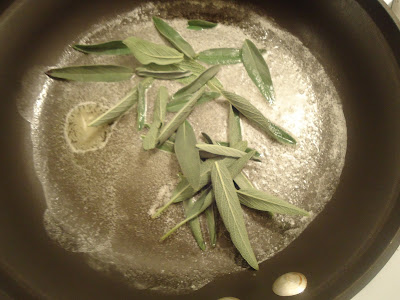
I have always had a "love affair" with crème brûlée. Literally translated to "burnt cream", it is a classic dessert, simply made with egg yolks, heavy cream, sugar, and vanilla beans. This mixture is whisked together, baked until the custard sets, chilled, and then "brûléed" with a little sugar on top (with help from a blowtorch) for an added sugary crust. Nothing beats tapping your spoon on top of the crust to break it, getting that perfect crust-to-custard ratio, and delighting in the burst of flavor and texture as it hits your mouth.
When I was a pastry chef, I strangely fell in love with making crème brûlées. I favored trying to create new and innovative ways of taking the basic flavors of the custard's base and changing things up a bit: some of the most popular brûlée flavors I concocted were Irish coffee, ginger infused with mango puree, and white chocolate with raspberry puree.
But the one that still stands out as my favorite to make is pumpkin crème brûlée. This recipe was handed down to me from the exiting pastry chef, and it was the first one I made at the restaurant I was working for. Due to the fact it was Thanksgiving-time when I started, we were elbow-deep in making hundreds of these crème brûlées for parties and events, as they were one of the most popular items on the dessert menu.
Being "that time of year" where pumpkin is everywhere, I decided to make them recently for a girl's dinner and then for Thanksgiving, to which rave reviews were handed down again. I had to pass it along.
(note: crème brûlées, though may appear daunting at first, are quite frankly very easy to make)
Recipe (makes about 5-6 regular ramekins and 10-12 small ramekins)
Ingredients:
1 1/4 C heavy whipping cream
1/2 fresh vanilla bean, split and beans scraped (or substitute 1 tsp vanilla extract)
5 egg yolks
6 tbsp sugar, plus extra for "brûlée"
1 tsp nutmeg
1/2 C solid packed pumpkin (canned version)
2 tbsp orange liqueur (optional)
Preheat oven to 325F.
First things first, add the cream to a small sauce pot; and the vanilla bean pod and beans to the cream; bring to a low boil (small bubbles all around edge of cream in pot) and turn off heat to allow vanilla to "steep" in cream, about 10 minutes.
While vanilla and cream are steeping, mix together egg yolks, sugar, nutmeg, pumpkin, and orange liqueur (optional). Whisk together well to combine.
After 10 minutes of cream and vanilla steeping, bring cream back up to a low boil. Remove from heat, and SLOWLY pour cream into egg-pumpkin mixture, whisking constantly. Make sure to scrape all leftover vanilla beans left in bottom of the pan into the mixture.
Remove vanilla bean pod from the mixture as you do not want to bake with these!
(This step can be made 1-2 days ahead; cover with plastic wrap and store in refrigerator until ready to use)
Next, pour pumpkin batter into ramekins. Place into large baking vessels where the lip of the vessel is higher than the ramekins because they will be baking in a water bath.
Fill the baking vessels with water, enough to almost reach the lip of each ramekin (by "lip" in the above photo, I am referring to the top portion of the ramekin where it is a bit thicker). Place in oven and bake until custard is set, about 20 minutes for regular ramekins and about 15 minutes for small ramekins (make sure to judge for yourself, every oven can be and is different!).
Remove baking vessels from oven, and place ramekins on a cookie sheet; wrap each individually with plastic wrap and store in refrigerator for at least 8 hours, preferably overnight, to allow the custard to set.
When ready to serve, sprinkle some sugar on top of the custard, and using a blow torch, brûlée the sugar on top to a golden brown.
And serve.
Slightly crunchy, sublimely creamy = just what you are looking for in a perfect crème brûlée. The added pumpkin and spices is just the hint of what is needed for this holiday season, and they balance beautifully with the richness from the eggs and cream.
And, with the now HUNDREDS of these pumpkin crème brûlées I have made over the last decade, the smiles on my guests faces in their sheer delight of this simple yet oh-so-flavorful dessert are indeed priceless.











































































